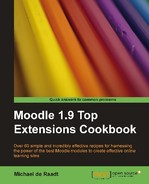|
Name |
Latest Blog Entries |
|
Module type |
Block |
|
Author |
Ludo (Marc Alier), Fernando Oliveira |
|
Released |
2006 |
|
Maintained |
Limited |
|
Languages |
English |
|
Compliance |
Good |
|
Documentation |
None available |
|
Errors |
None displayed |
Blogs are a great way of encouraging students to reflect on their learning. Personal blogs in a Moodle site can be shared and read by other users, regardless of course. One of the main reasons people write blog entries is so that their words can be read by others. However, apart from viewing personal blogs through users' profiles, there is not a simple way of announcing user's blog entries on course pages.
The Latest Blog Entries block promotes the blogs of course participants by advertising their latest postings. This block seems to have been abandoned by the original author, but another developer has released an updated version of the block which you will find attached to the original Modules and plugins database entry for this block. This review is based on that updated version.
Unzip and copy the fn_updated_blogs directory into the /moodle/blocks/ directory then visit the Notifications page.
When first added, you will be asked to set values for global settings associated with the block.

The first setting controls how many blog entries are advertised in the block. Entries are limited to titles and a few other details, so each blog entry does not take up much space, however, if screen real-estate is tight on your course pages, perhaps a lower maximum may be appropriate.
The second global setting relates to the presentation of blog updates. The original version of this block showed entries as rows in a table with features presented in separate columns. The updated version offers a view with each entry as a single row containing a number of lines rather than columns. This updated view provides a less cramped presentation of entries, so the default Rows option is what you will probably want to use.
At the course page, a Latest Blog Entries block can be added by selecting FN Updated Blogs from the Blocks menu.
When the block is added you will want to edit the single configuration setting.

This setting allows you to use a more meaningful title compared to FN Updated Blogs. For a remedy to change the default setting globally, see the There's more... section of this recipe.
The block will show recent blog entries, grouped together by date.

Ultimately the purpose of using this block is to draw students into the blogs of other users, and hopefully promote the use of blogs by all users. A second block that you might, therefore, want to add alongside the Latest Blogs Entries block (preceding screenshot) is the standard Blog Menu block. This block allows users to quickly access their own blog and begin writing.
Blogs are a great example of social computing. They are an easy-to-use tool, allowing students and teachers to report their thoughts and experiences. Reflection is a higher-level cognitive task, so encouraging reflection allows users to have a deeper learning experience and become more aware of what they do and don't understand.
Blogs also provide the potential for students to build on the knowledge of their peers. This engenders a community of learning, allowing learners to feel less isolated in their studies, regardless of whether they are located close by or separated by great distances.
Blogs allow students to develop public writing skills, which are becoming far more valuable as electronically mediated communication becomes a greater part of our lives.
The updated version of the Latest Blog Entries block uses the title FN Updated Blogs in the Blocks list and as a default title for new instances of the block. This title might not be meaningful to teaching.
There are two ways to change this title. The first is to edit the block_fn_updated_blogs.php file located in /moodle/blocks/fn_updated_blogs/lang/en_utf8/ directory.
The other way to make minor changes to a module's language strings is by using Moodle's Language editing tool. While logged in as an administrator, navigate to your site's root page. In the Site Administration menu, expand the Language item and click on Language editing. You will be asked to choose a language from the languages installed in the system. Assuming you choose English(en) you will be able to edit English language files. This tool is also useful for creating translations for other languages, although perhaps not as convenient as editing the language files themselves. With your language selected, click on the link titled Edit words or phrases. You will be presented with a drop-down list of installed modules. Contributed modules are listed at the bottom of this list. Locate the block_fn_updated_blogs entry.

Make changes to the two strings labeled FN Updated Blogs and save changes using the button at the bottom of the page.
